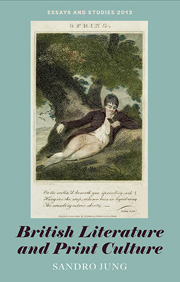Book contents
- Frontmatter
- Contents
- List of Illustrations
- Notes on Contributors
- Introduction
- Tracing a Genealogy of Oroonoko Editions
- The Pilgrim's Progress, Print Culture and the Dissenting Tradition
- Printing for the Author in the Long Eighteenth Century
- Robert Burn's Interleaved Scots Musical Museum: A Case-Study in the Vagaries of Editors and Owners
- Packaging, Design and Colour: From Fine-Printed to Small-Format Editions of Thomson's The Seasons, 1793–1802
- Print Illustrations and the Cultural Materialism of Scott's Waverley Novels
- Beyond Usefulness and Ephemerality: The Discursive Almanac, 1828–60
- The Last Years of a Victorian Monument: The Athenaeum after Maccoll
- Index
Print Illustrations and the Cultural Materialism of Scott's Waverley Novels
Published online by Cambridge University Press: 05 October 2013
- Frontmatter
- Contents
- List of Illustrations
- Notes on Contributors
- Introduction
- Tracing a Genealogy of Oroonoko Editions
- The Pilgrim's Progress, Print Culture and the Dissenting Tradition
- Printing for the Author in the Long Eighteenth Century
- Robert Burn's Interleaved Scots Musical Museum: A Case-Study in the Vagaries of Editors and Owners
- Packaging, Design and Colour: From Fine-Printed to Small-Format Editions of Thomson's The Seasons, 1793–1802
- Print Illustrations and the Cultural Materialism of Scott's Waverley Novels
- Beyond Usefulness and Ephemerality: The Discursive Almanac, 1828–60
- The Last Years of a Victorian Monument: The Athenaeum after Maccoll
- Index
Summary
The extensive influence of scott's fiction on art in the nineteenth century has long been a subject of commentary, while a parallel, if less developed, line of enquiry has examined the symbiosis between text and illustrative material in the production of collected sets of the Waverley novels. Until recently, however, general analysis has largely concentrated on exhibition painting, quantifiable as it is from sources such as the catalogues of the Royal Academy and British Institution. Catherine Gordon thus points to the exhibition by over three hundred painters and sculptors of more than a thousand Scott-related works between 1805 and 1870, with an increasing choice of the novels rather than poetry for subject-matter. Likewise, Richard Altick locates an equivalent heyday for Scott illustration: ‘The great age of Scott painting was the period 1830–50. During those two decades, well over 400 examples were exhibited, an average of more than twenty a year.’ Though never openly stated, in both critics one senses an underlying feeling that print illustrations were for the most part an offshoot of this ‘primary’ field of activity. However, there are a number of reasons for believing the opposite to have been the case, with the print market providing the chief motor force for the production of Scott imagery. In many instances paintings and drawings were commissioned for engraving first, and only exhibited subsequently.
- Type
- Chapter
- Information
- British Literature and Print Culture , pp. 125 - 157Publisher: Boydell & BrewerPrint publication year: 2013



